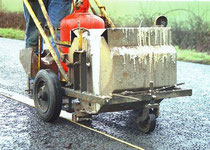BASIC "TROLLY" DESCRIPTION

The hopper at the back contains the glass beads.
The glass beads are discharged from the hopper on to a flat plate that spreads the beads to the width of the line.
The flow of beads is adjusted to a rate to achieve the initial retro-reflectivity requirement stated in the contract document.
It is not uncommon to state a rate of beads as 70% of the amount that would be required to achieve shoulder to shoulder cover when tested in the laboratory.
But less than this amount may achieve the required retro-reflectivity stated in a performance based specification.
The element that is critical is that the glass beads must be applied to the surface of the screeded thermoplastic while it is still in a molten state to ensure that the beads will form a firm bond with the thermoplastic.
There are various "coatings" that can be applied to the glass beads in manufacture to improve the bonding process.
Post time: Aug-28-2024







